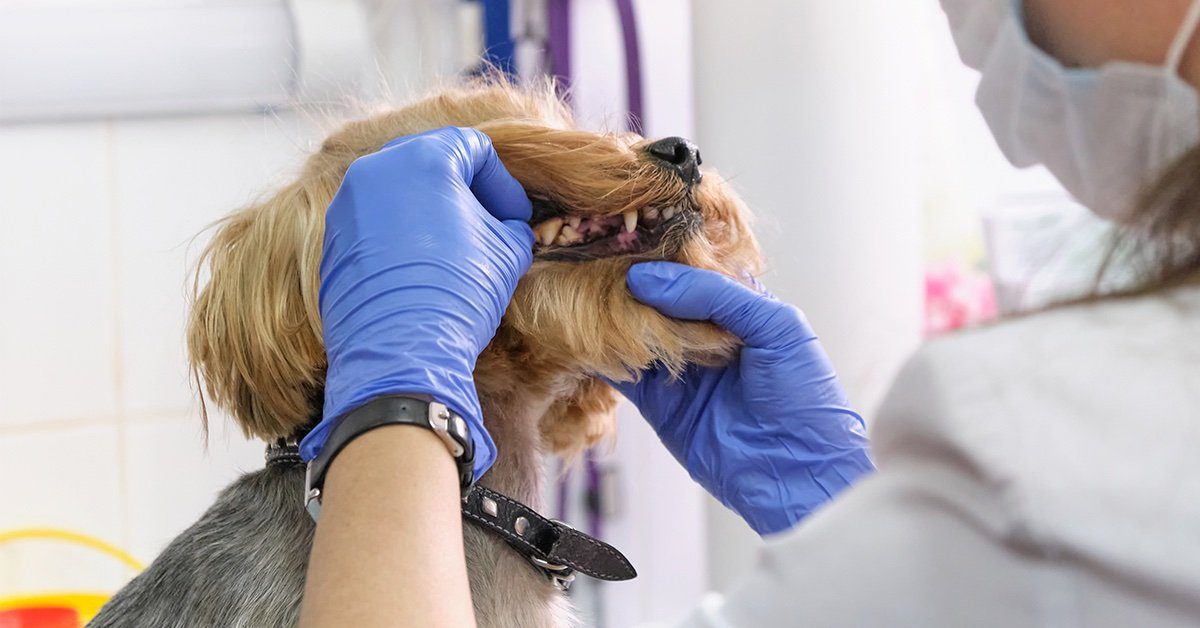When was the last time you brushed your dog’s teeth? Just like humans, your fur friends need a thorough tooth brushing routine to keep their oral health in tip-tail shape. Without proper dental care, your dog can develop some worrisome and costly health problems – including periodontal disease.
What exactly is periodontal disease? Periodontal disease, or periodontitis, is a type of gum disease that’s incredibly common in dogs. According to VCA Hospitals, over 80% of dogs above three years of age have active periodontal disease, making it the most prevalent doggie dental problem. Fortunately, while periodontal disease can lead to troubling complications, there are a number of ways to prevent, spot, and treat it. We dig into these below.
How periodontal disease in dogs works
When your dog chows down on breakfast and dinner (not to mention all the treats in between!), food, saliva, and bacteria clump together on their teeth. Over time, those food clumps thicken into a substance called plaque, which if left long enough, hardens into tartar. While humans brush their teeth to remove that plaque buildup, it tends to remain on your pet’s teeth for much longer, leading to inflammation of the gums, or gingivitis.
Fortunately, gingivitis is reversible, but the later stages of periodontal disease aren’t. Once the infection spreads further into the tooth socket, bone erosion and tooth loss can occur, and your pup may experience painful side effects.
How to spot periodontal disease in dogs
Periodontal disease can be hard to identify, especially in its early stages. Dog owners should be on alert for bad breath, or what vets call halitosis – one of the first signs of periodontal disease. Other early red flags are red, puffy, or bleeding gums.
As periodontal disease progresses in dogs, they may experience pain while chewing or opening and closing their mouth, which can interfere with their usual eating habits. Growths inside the mouth are another sign, as are loose or missing teeth. Be on the lookout for any changes of behavior, especially involving your dog’s mouth.
All dogs can develop periodontal disease, but small breed dogs are at a higher risk. Smaller mouths have crowded, tiny teeth that trap food more easily, leading to quicker plaque build up. At the same time, small dogs have less bone mass anchoring each tooth, making it easier for the tooth’s root to rot. The parents of tiny pooches – including Pugs, Collies, Yorkies, Chihuahuas, Daschunds, Maltese, and Boxers – should be on high alert.
Treatment options for periodontal disease in dogs
If you’re concerned your dog has periodontal disease, schedule an appointment with your vet. They’ll be able to perform a full oral examination and determine whether your dog has periodontal disease and how far it has progressed. If your dog is diagnosed with dental disease and tartar (advanced periodontal disease) they’ll need a professional dental cleaning because tartar can’t be removed with brushing alone.
A dental cleaning usually involves an examination with x-rays to determine if bone loss has occurred beneath the gum line or any other abnormalities. A full dental exam includes probing periodontal pockets, as well as scaling and polishing of your pet’s teeth. Scaling and polishing removes tartar and plaque above and below the gum line and makes your dog’s teeth smoother, which helps reduce plaque buildup after the cleaning. Your dog will be under general anesthesia for the procedure, as cleaning under the gum line cannot be performed safely in dogs that are conscious. Bloodwork is generally run before anesthesia to ensure your dog’s health for the procedure. In instances with very severe periodontal disease, tooth extraction may be the only option.
Pet Pro Tip: Illnesses won’t wait to happen. You shouldn’t wait to enroll in pet insurance. From common parasite infections, to costly hereditary illnesses, dog insurance is worth it and can cover crucial eligible treatment your pet may need for their unexpected accidents and illnesses. Find out how dog insurance works, what pet insurance covers, and choose a plan today.
How to prevent periodontal disease in dogs
The best way to protect your pup from the effects of periodontal disease is to protect them from developing it in the first place. Most vets recommend brushing your dog’s teeth every day with a canine-safe toothpaste (human toothpaste often contains fluoride, which is toxic to dogs). You can also purchase toothbrushes specifically designed for dogs. Some slip directly onto your finger so you can gently clean your pet’s teeth, making the process easier.
If your pooch is still resistant to brushing, or you find yourself short on time, look into alternatives like treats, chew toys, or water additives that help break down plaque and tartar. Dental diets are also becoming popular among pet owners as they’re specially formulated to help remove plaque and tartar that build up on the tooth’s surface. Your vet can provide a recommendation for these home care products. While brushing remains the best preventive measure, removing any amount of plaque and tartar can be helpful in protecting your dog’s oral health.
Cost of treating periodontal disease in dogs
Teeth cleaning for your pup can be costly, ranging from a few hundred to several thousand dollars. The cleaning process generally takes an hour, sometimes more, and requires costly x-rays and anesthetics to ensure your pup gets the care they need. Tooth extractions can add to the time it takes to treat periodontal disease – and the cost.
Of course, these costs will vary depending on your vet clinic, your pet insurance plan, and where you live. But, above all, the best way to avoid the costs associated with periodontal disease is to help your pooch maintain good oral hygiene with daily brushing to protect their teeth before problems develop.
Unlike a lot of pet insurance plans out there, Pumpkin’s dog insurance plans can help you say ‘yes’ to the best care if your pup develops oral illnesses like periodontal disease in the future.
*Pumpkin Pet Insurance policies do not cover pre-existing conditions. Waiting periods, annual deductible, co-insurance, benefit limits and exclusions may apply. For full terms, visit pumpkin.care/insurancepolicy. Products, discounts, and rates may vary and are subject to change. Pumpkin Insurance Services Inc. (Pumpkin) (NPN#19084749) is a licensed insurance agency, not an insurer. Insurance is underwritten by United States Fire Insurance Company (NAIC #21113. Morristown, NJ), a Crum & Forster Company and produced by Pumpkin. Pumpkin receives compensation based on the premiums for the insurance policies it sells. For more details visit pumpkin.care/underwriting-information and pumpkin.care/insurance-licenses.




